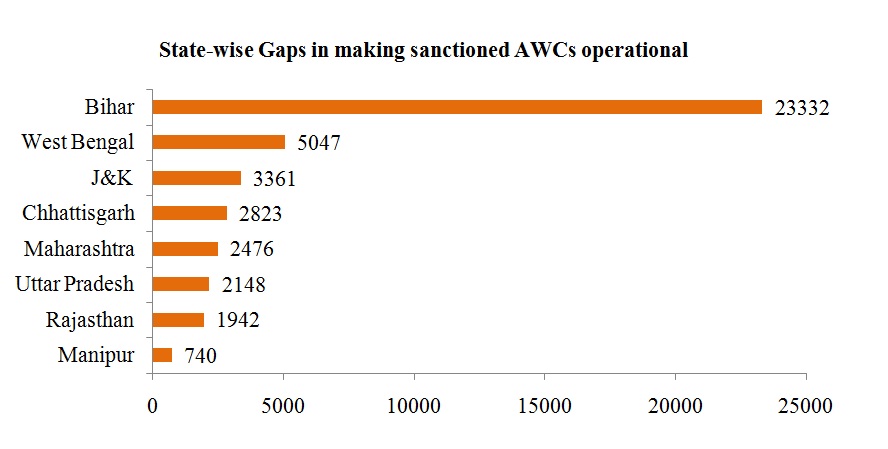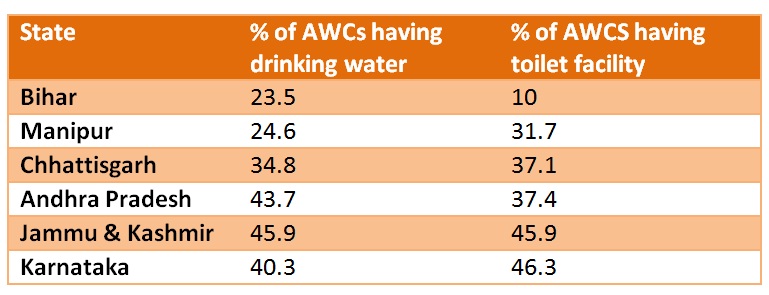
A recent proposal by the Women and Child Development (WCD) Ministry seeks to amend the construction guidelines for Anganwadi Centres (AWC) planned for the next four years. Instead of building 50,000 AWCs per annum, the Ministry aims to expand the number by 100% to 1 lakh such centres annually. In addition, these new Anganwadis are to be run as a shared space with 50% of the time being spent on child welfare activities and the remaining half on supporting women’s skill development.
As on December 31, 2014, the targeted number of sanctioned Anganwadis was 14 lakh out of which 13.42 lakh are operational. A CAG Performance Audit of the Integrated Child Development Services (ICDS) scheme lists non-finalisation of location, site disputes and delay in finalisation of tenders as some of the main reasons for slow progress of works. As shown in the chart below, states with critical capacity gaps include Bihar, West Bengal, Jammu & Kashmir and Chhattisgarh.

The acute shortage of AWCs across states creates the need to ramp up construction so that 4 lakh AWCs can have children-friendly buildings by 2019. This need is compounded by the fact that 32.56% of existing AWCs operate out of rented buildings while 18.81% do not even have pucca buildings. Running the centres on rented accommodation raises issues of lack of space and hurdles in check-up for the women beneficiaries. More than 50% of AWCs in NCT of Delhi, Jammu & Kashmir, Andhra Pradesh and Bihar do not have their own premises. To address these concerns, WCD has specified that the new centres should have infrastructure, like a sitting room for children, a kitchen and a minimum of 600 square feet space for playing.
The chart below shows the states with the weakest infrastructural capacity for AWCs.

As per Ministry instructions, child-friendly toilet and drinking water facility are the basic minimum requirements for the effective functioning of an AWC. The absence of these basic amenities creates unhygienic conditions and adversely affects the quality of services provided to the intended beneficiaries.Such conditions can result in high absenteeism and low enrolment. The Demand for Grants Report (2015-16) of the Ministry of WCD observes that in terms of toilet facilities in AWCs, barring a few States like Nagaland, Uttarakhand and UTs like Chandigarh, Delhi, Daman and Diu and Lakshadweep, almost all the States have a long way to go to achieve this target. Out of the 13.42 lakh operational AWCs in the country, only 6.48 lakh AWCs have a toilet in the premises. An even lesser number of Anganwadis have drinking water facilities.

Despite a consistent increase in the allocations over the last three years, the allocation for 2015-16 for ICDS has been reduced by 45% from Rs. 15128.77 in the previous year to Rs. 8335.77. It remains to be seen whether the Ministry can meet its targets to ensure the required infrastructure and delivery of services in the Anganwadi centres.
The author is an Analyst at Swaniti Initiative. She is currently working on providing knowledge insights on key government programmes to Parliamentarians.